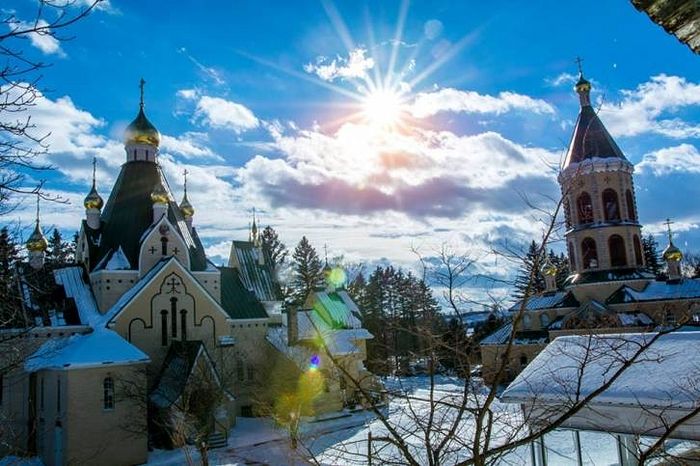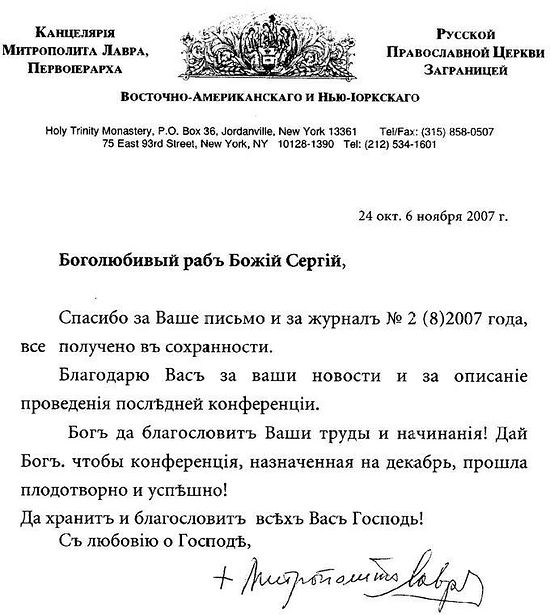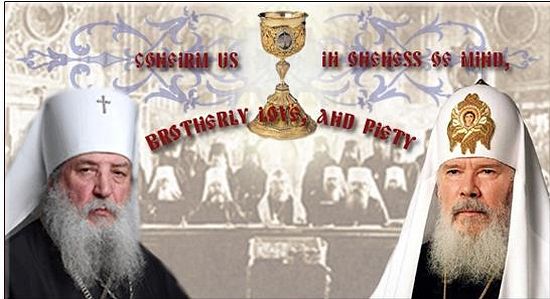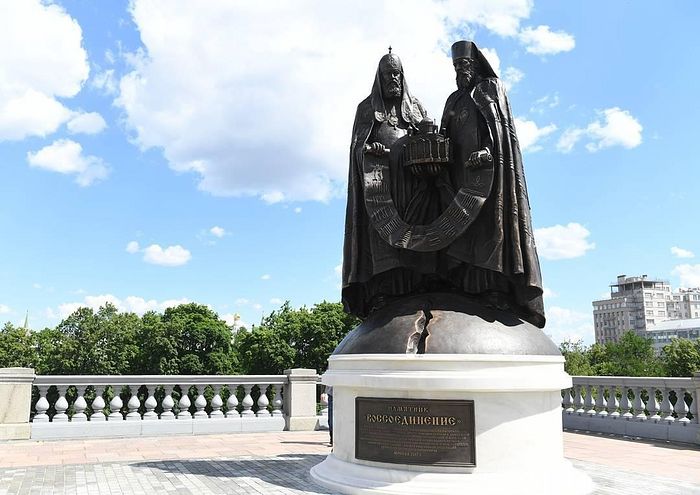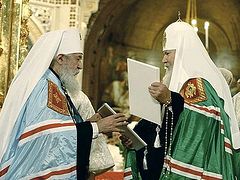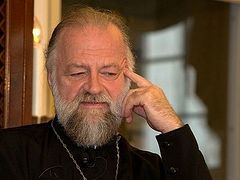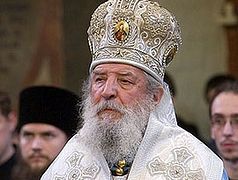Behold, how good and how pleasant it is for brethren to dwell together in unity! (Psalm 132:1)
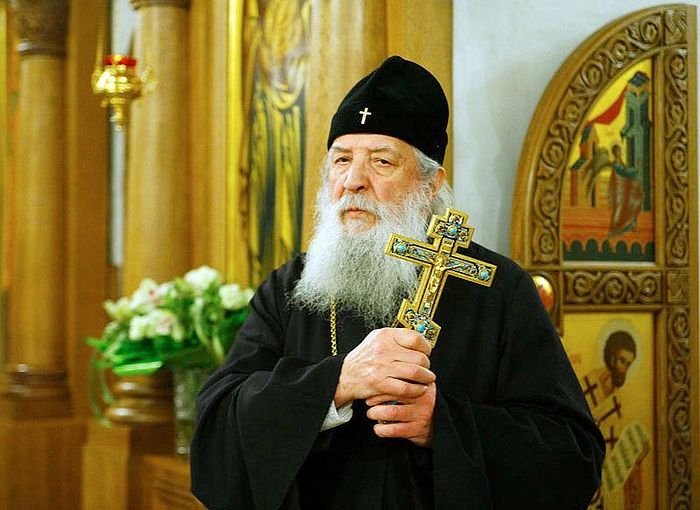 Metropolitan Laurus at St. Catherine's, the representation church of the autocephalous Orthodox Church in America in Moscow. A ROCOR hierarch serving at an OCA church in Moscow was truly a blessing from God.
Metropolitan Laurus at St. Catherine's, the representation church of the autocephalous Orthodox Church in America in Moscow. A ROCOR hierarch serving at an OCA church in Moscow was truly a blessing from God.
Glory to Jesus Christ—Glory forever!
Twelve years have passed since the day of Vladyka’s repose, in eight more years, he would have been one hundred, but on March 16, 2008—The Sunday of the Triumph of Orthodoxy—Metropolitan Laurus (Škurla) departed to his eternal reward.
One can only imagine what that reward must be for a man who reunited the Church.
Who was Metropolitan Laurus? He was a Carpatho-Rusyn, sometimes called a Lemko,1 (which is one of the western-most tribes of Rusyns).
He was a giant from the lonely Carpathian Mountains, who much like his spiritual brother, Metropolitan Onuphry of Kiev, had a kindred spirit to the ancient God-pleasers.
By age five, he already felt the call to monasticism. As a monk he carried the very same medieval printing mission started by Saint Job of Pochaev in Volhynia, halfway around the world to New York. As a cleric he served together with Saint John of Shanghai. He was a Bishop, just like Saint John. He was the First Hierarch of the Church Abroad. He was the Primate who together with Patriarch Alexy II, reunited the Russian Church.
Metropolitan Laurus was our father, and his memory is eternal in Holy Rus’.
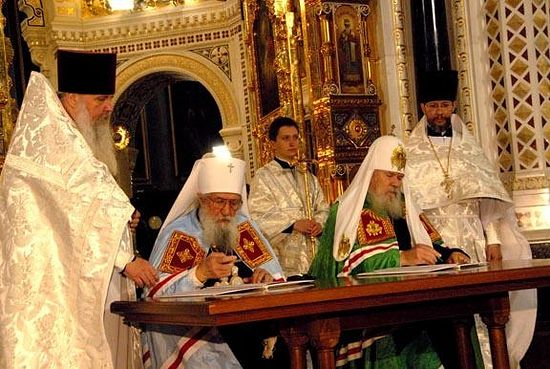 The reunification of the Russian Church
The reunification of the Russian Church
Early Life in Carpathian Rus’
Met. Laurus was born Vasyl’ Škurla (pronounced: Shkúr-la), on January 1, 1928, to Mikhail Ivanovich and Elena Mikhaolovna Škurla in the village of Ladomirová which was then part of Czechoslovakia. He was a true Carpatho-Russian or Rusyn, which is why we certainly included him in our article: The Mountainous Achievements of the Carpatho-Rusyns.
The village of Ladomirová, related to Lodomeria, the Latin name for Vladimir-of-Volhynia,2 is part of the region called Priashevshchina or Priashevina3, or Prešov Rus’. This now corresponds to the Prešov region in modern Slovakia.
 Ladomirová. Michal Kosťo Kosterec. https://www.facebook.com/pg/Ladomirov%C3%A1-353048193015/photos/?ref=page_internal
Ladomirová. Michal Kosťo Kosterec. https://www.facebook.com/pg/Ladomirov%C3%A1-353048193015/photos/?ref=page_internal
As the Synodical website describes, this can be counted as part of “Praguean” 4 Rus’, on “westernmost border of Ugrian [Hungarian—Trans.] Russia, which before the Great War, was part of the Austro-Hungarian Empire.”5
As Rusyn Archpriest Dimitry Sydor, (Dean of Uzhhorod’s Christ the Savior Cathedral in Transcarpathia, and possibly the foremost expert on Rusyn matters today) explains, the ancient land of Carpathian Rus’ was connected to Bohemia6 and Great Moravia, where the mission of Saints Cyril and Methodius took wing. Carpathian Rus’ was quite possibly baptized by the Apostles to the Slavs before the Baptism of Rus’ itself in Kiev (988), and pre-dates Kievan Rus’.78
It is truly meet to call these lands, which were always under the protection of the Theotokos, “the cradle of Slavdom”, as described on the website of the ROCOR synod, and this part of the Russian Orthodox people in the Carpathians as, “heroic”.9
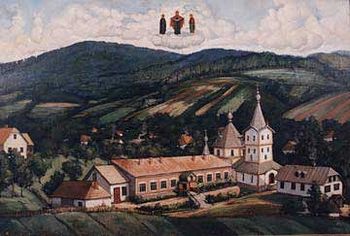 The Monastery of St. Job in Ladomirová in Slovakia by Archimandrite Cyprian (Pyzhov), Jordanville, New York. ROCOR Studies.org
The Monastery of St. Job in Ladomirová in Slovakia by Archimandrite Cyprian (Pyzhov), Jordanville, New York. ROCOR Studies.org
Few people suffered more under the yoke of papist empires: From the expulsion of the Slavic monks of Sázava, the destruction of their books, and forced Latinization in December of 1096,10 to the invasion of Bohemia by Sigismund of Hungary and the Hussite Wars—in which one of the Volhynian Saints, Theodore of Ostrog, fought11—to the Unions of Brest and Uzhhorod, and the martyrdom of Saint Maxim Sandovich, the Transcarpathian peoples suffered greatly under the Austro-Hungarian Empire.
Metropolitan Laurus was from one of those brave Rusyn families that remained Orthodox. He was baptized by Archimandrite Vitaly (Maximenko), Archimandrite of Pochaev Lavra, who, blessed by Met. Anthony Khrapovitsky, founded the St. Job of Pochaev Monastery and Brotherhood in Ladomirová, continuing the printing work of St. Job there in Czechoslovakia.
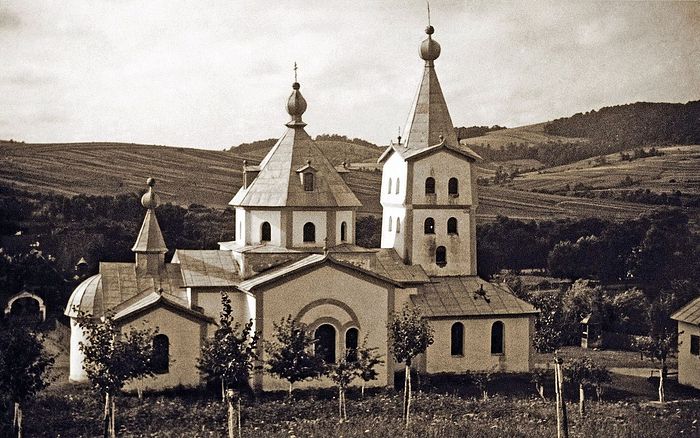 The Monastery of St. Job in Ladomirová, Archives of Holy Trinity Seminary.
The Monastery of St. Job in Ladomirová, Archives of Holy Trinity Seminary.
Vladyka Laurus served in the altar there since age five—he already felt the call to monasticism. Despite the fact that he had to attend school, the young child fulfilled all strict monastic rules that most adults could not, waking “for the midnight office at 4 am., standing throughout all the long monastic services without fail.”12
At age 12, in 1940, the successor of Met. Anthony Khrapovitsky as first hierarch of ROCOR, Met. Anastasius (Gribanovsky) blessed Vasyl’, and prophesied that he would become a pastor.13 He spent the rest of his early years in the monastery of his Carpathian home.
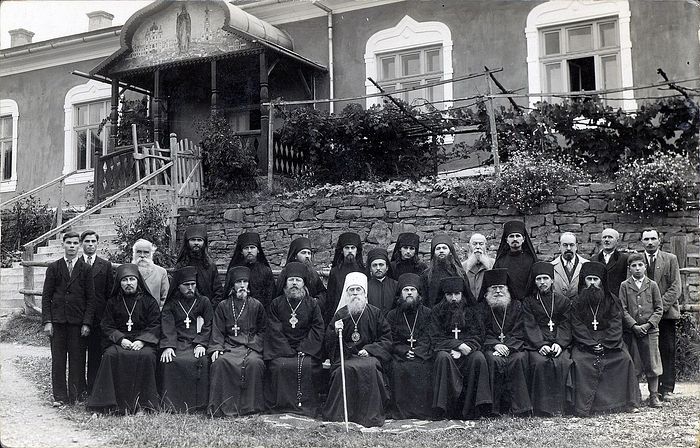 The visit of Met. Anastasius to the monastery, note the depiction of Pochaev over the portico on the top left. The twelve-year-old Vasyl’ on the far right, is the future Metropolitan Laurus.
The visit of Met. Anastasius to the monastery, note the depiction of Pochaev over the portico on the top left. The twelve-year-old Vasyl’ on the far right, is the future Metropolitan Laurus.
In 1944, the Red Army was approaching the Carpathians, which they would occupy. As we described in part two of our series on Rusyns, figures like St. Alexy (Kabalyuk) in Subcarpathia fought that if the Rusyn lands were to be absorbed by the Soviets, there would at least be created for them a sort of Transcarpathian Republic, so that this unique westernmost Rus’ people could continue their cultural development, and avoid being absorbed into a surrounding nation. Stalin and Khrushchev, however, forcibly Ukrainianized Transcarpathia, driving many Rusyns happily settled in Poland and Slovakia into Soviet Ukraine, and destroying the idea of an autonomous Rusyn territory in Czechoslovakia.
The Brotherhood of St. Pochaev published the famous journal “Pravoslavnaya Rus’”14 which was anti-communist, and confessed the correct version of Russian history; and as a result, with the advance of the Soviets in 44’, it was clear to them that they had to flee—to leave the Carpathians forever, and join the mass exodus of so many Rusyns to America. Vasyl’ was among the last to leave, and was practically forced by the other brothers out of fear for his life.
The brotherhood went to Bratislava, and onto Germany and Switzerland, and eventually reached Holy Trinity Monastery in New York by 1946; Vasyl’ left the only home he ever knew, but through God’s grace, Jordanville became for him a reborn Ladomirová—little did he know he would one day become the abbot!
The Carpathians became a second Golgotha, but Orthodoxy endured the Cross and beheld the Resurrection: The diocese of Prešov of the Church of the Czech and Slovak Lands is thriving today; Carpathian Rus’ lived on abroad too—Jordanville became an heir to Pochaev! Glory to Jesus Christ!
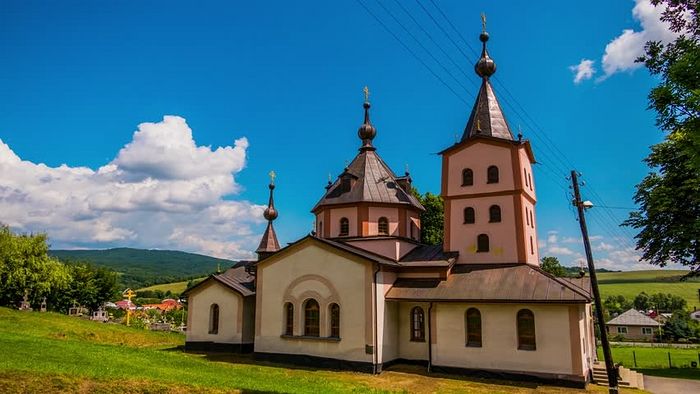 The Monastery of St. Job in Ladomirová today.
The Monastery of St. Job in Ladomirová today.
Holy Trinity Jordanville Monastery—the heir of Pochaev
What happened in Jordanville was a match made in heaven; the relatively new monastery desperately needed monastics, and the brotherhood of Saint Job from the Carpathians needed a new home. Led by figures such as Archbishop Vitaly (Maximenko), Archimandrite Seraphim (Ivanov), and Archbishop Averky (Taushev), who intimately knew and loved Pochaev, Ladomirová, and Carpathian Rus’, something amazing happened in Jordanville.
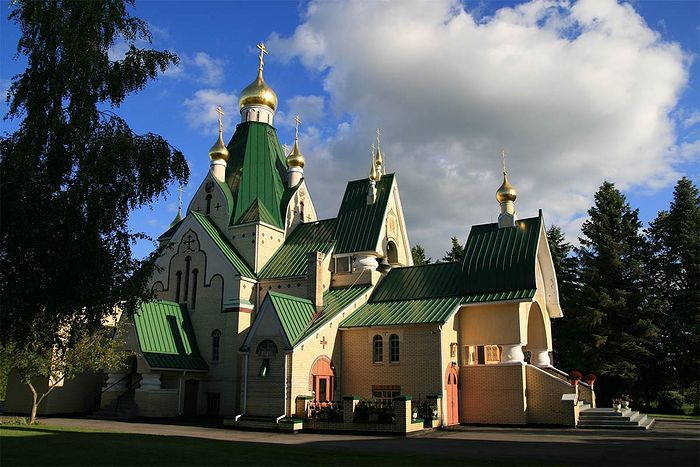 Holy Trinity Monastery, Jordanville.
Holy Trinity Monastery, Jordanville.
Holy Trinity Monastery became a synthesis of the Carpathian-Pochaev tradition with the new American diaspora mission. For Vladyka Laurus, Jordanville became a new home, and his memories of Ladomirová perfectly blended in with Jordanville; and just as Western Rus’ can never be separated from Eastern Rus’, so too can Pochaev and Jordanville never be separated. By God’s providence, they became part of one spiritual continuum. This was and always will be the destiny of the Church Abroad, to bear these traditions from all across Rus’, preserve them, and bring them together in unity with the entire Orthodox world. Metropolitan Laurus lived to see all of this.
“I don’t chat in the altar.”
How St. John of Shanghai passed a ROCOR tradition onto Vladyka Laurus
The following is a translation from possibly the greatest book on St. John of Shanghai; in this story, Vladyka Laurus recalls a memory of St. John:
In 1953, members of the Bishops Council visited Holy Trinity Monastery in Jordanville. I was then a hierodeacon. After the festal liturgy, I went to the altar and found Saint John there, who was looking for something. I went to Vladyka John and asked him: “May I help you find something?” Saint John did not answer my question, and silently continued his search. Then I, thinking that Vladyka John had simply not heard the question well, asked him again. Saint John then took my hand, led me out of the altar, and said: "I don’t chat in the altar.”15
That little story gives such insight into the spiritual witness of the ROCOR, which always maintained two key doctrines:
-
That there can be no unity in the Church without right-belief (Orthodoxy).
-
And there can be no right-belief without right-practice (Orthopraxy).
This is the way of the ROCOR. That right-practice of the utmost reverence for the Holy Altar taught by St. John is still alive today. His Eminence, Archbishop Peter (Lukianov) of Chicago and Mid-America, a spiritual son of St. John, follows this discipline; I can confirm this by personal experience—whenever you serve with Vladyka Peter, whenever he serves in general, you can feel the spirit and inheritance of St. John. Perhaps St. John gave Vladyka Peter a little piece of his heart, just as Met. Anthony (Khrapovitsky) gave to St. John those years ago.16
Vladyka Laurus is also spiritually connected to Met. Anthony, and not only through Archbishop Vitaly. Our Blessed Abba Anthony was the Metropolitan of Kiev and Galicia (previously Archbishop of Volhynia) after all, and the spiritual father to many Carpatho-Rusyns; he greatly supported the Carpathian Mission, and figures such as St. Alexy (Kabalyuk). Metropolitan Anthony guided and ordained to the priesthood the Hieromartyr of Carpatho-Russia, St. Maxim Sandovich of Gorlice.17 Orthodoxy in America, and especially Pennsylvania, New York, and North-Eastern Ohio was practically saved by Rusyns Christians.
All of North American Orthodoxy owes the Ruthenians a great debt.
The Printing Press of Saint Job
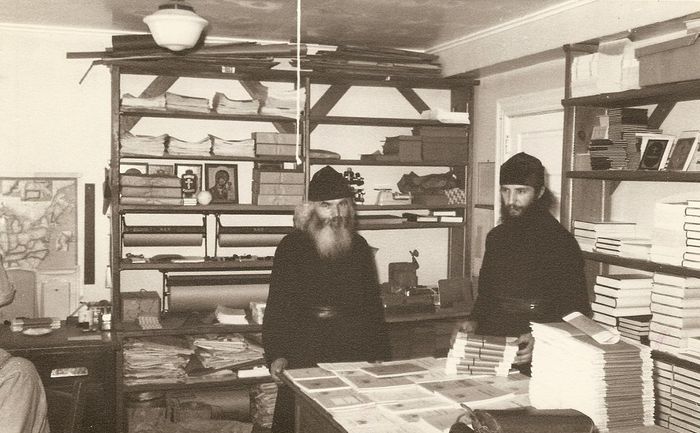 The Monastery Printing Shop. On the right stands the future first Hierarch of the ROCOR, Met. Laurus.
The Monastery Printing Shop. On the right stands the future first Hierarch of the ROCOR, Met. Laurus.
Of great importance was Vladyka’s life-long work in the printing house of Saint Job of Pochaev. The Venerable Job is the quintessential Volhynian father, one of the greatest saints of the Russian Church, who is remembered just as much for his polemic defense of Orthodoxy against union with Rome as his awesome miracles.
If Saints Cyril and Methodius are the Apostles to the Slavs, then Saint Job is, together with St. Peter Mohyla, Konstanty Wasyl Ostrogski [Konstantine Vasilievich Ostrogsky.—Ed.], and Ivan Fyodorov of Moscow and Lviv, one of the Four Evangelists of Slavic Printing.
Saint Job worked with the help of the Ruthenian Prince Konstanty, one of the foremost of the Polish-Lithuanian nobility, to publish the first printed Slavic bible—the Ostrog Bible. His work was crucial in saving the missionary work of Saints Cyril and Methodius. The Latins first annihilated it in Bohemia and Great Moravia, in Sázava monastery where they destroyed the Church Slavonic labors of Sts. Cyril’s and Methodius’s spiritual son Saint Procopius, and after the Union of Brest, they sought to destroy it in Ruthenia; but Saints Job and Peter (Mohyla) put a stop to it.
The printing press of Saint Job is therefore of the utmost symbolic value for Orthodoxy in Western Rus' and the entire Russian Church. It is a living testimony to the words of St. Athanasius of Brest, who was martyred by the Uniates, who declared that the Unia would forever be “anathema”, and its followers, lest they repent, among the accursed.
The printing press of Saint Job was a more powerful defense than the considerably mighty walls of Pochaev Lavra.
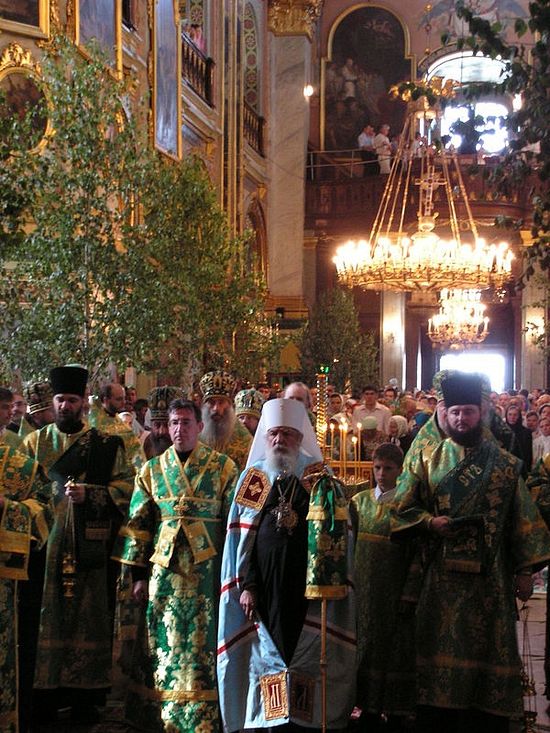 A glorious homecoming—Metropolitan Laurus in Pochaev
A glorious homecoming—Metropolitan Laurus in Pochaev
The memory of bygone years, one thousand years of Russian Christian history, has been confessed there.
Met. Laurus was part of that great generation of Pochaevite monks and brothers who rescued the printing press from the godless Soviet authorities, who surely would have destroyed it.
Met. Laurus followed the brotherhood with the printing press to America, where he carried out his obedience there at the Holy Trinity Jordanville Monastery.
Throughout his Hierarchical service, he never abandoned the printing press, but rather expanded it; and when it came time, he eventually delivered it into the capable hands of now-Bishop Luke, a fellow Carpatho-Russian, his successor as Bishop of Syracuse and Abbot of Jordanville. And how ironic that Vladyka's successor as First Hierarch, Metropolitan Hilarion, is of Volhynian heritage, just like Saint Job.
The Church connects and completes us in the most beautiful ways.
Serving Holy Rus’
One of Vladyka’s most well known traits was his humility. Even as a hierarch, he never viewed himself as above service—he felt it was the destiny of all Russian Orthodox Christians to serve Holy Rus’, which is not an empire, a state, or ethnicity, but the spiritual union of Orthodoxy in the lands of Rus’. This is precisely the origin of phrases like American Rus’, Pennsylvanian Rus’, Canadian Rus’, (and my favorite) Clevelandsky Posad18—wherever there is the Russian Church and her traditions, there is Holy Rus’. Vladyka served that same Holy Rus’ all the days of his life, as did the ancient Metropolitans of Kiev.
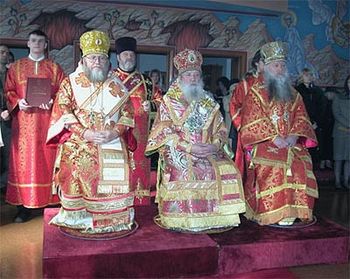 Metropolitan Laurus (center), beside his successor, now-Metropolitan Hilarion (left), and then-Bishop of Cleveland Peter (Lukianov). St. Sergius Russian Orthodox Cathedral, February 6, 2005, Cleveland, Ohio.
Metropolitan Laurus (center), beside his successor, now-Metropolitan Hilarion (left), and then-Bishop of Cleveland Peter (Lukianov). St. Sergius Russian Orthodox Cathedral, February 6, 2005, Cleveland, Ohio.
In 2005 in Moldova, a land with significant Ruthenian ties, an academic journal called “Rusyn” was founded, which was possibly the best in its field, and is now published with the help of Tomsk State University. Metropolitan Laurus, as their site (also available in English) reports, extended his Primatial blessing on this publication dedicated to his people.
In 2007, they published a letter from Met. Laurus, and correspondence between him and their society, “Rus’”, which publishes the journal. After having read one of their articles concerning the history of ethnic Rusnaks in Moldova, Metropolitan Laurus replied:
“I want to wish you God’s help in this important work. Our Rusyn nation has endured all manner of adversities, and certainly the clarification of the historic position of this question is very important. The Lord bless you and help you and your coworkers to serve our long-suffering nation. Godspeed to you!”19
The editors of Rusyn emphasized especially the following correspondence from Vladyka Laurus:
“Great and beautiful is the spiritual wealth of our nation, and it is crowned with two words: Holy Rus'. We must serve this Holy Rus as our Saints served her: Holy Hierarchs, Princes, venerable fathers, and righteous laity. But not only Saints may serve Holy Rus'. “Small folk” also serve her, some by singing, participating in Divine services and working in the church, some by helping the poor and other acts of the merciful charitable heart, others by educating and raising the younger generation in the spirit of our nation, some by a prayer unheard by anyone but God for our motherland and her children. We are all called to serve Holy Rus'.”20
Metropolitan Laurus presided over the local glorification of Saint Paisius Velichkovsky, another great saint from South-Western Rus’ who lived among the Romanian Carpathians, at the Skete of the Holy Prophet Ilia on Mount Athos. It is also worth noting that Vladyka bore a strong resemblance to His Beatitude, Metropolitan Onuphry of Kiev and All Ukraine—they could practically have been brothers.
The Reunification of the Russian Church
A Chalcedonian Solution
Let us never forget that it took a Rusyn to unite the church.
It seems to be divine Providence that God would choose a Rusyn to lead the Russian Church back into full unity. This not only immortalizes yet again their indispensable contributions to the Russian Church, but also symbolizes the unity thereof—a Bishop from the most distant and divided region of all Rus’ leading the reunion movement with the Patriarch! To paraphrase the findings of the Bishops Council of the ROC after the reunification: The uniqueness of national and cultural identity between different parts of historical Rus’ has always formed the strength of the Holy Russian Church.21
This is a perfect example of the essential and inalienable Ruthenian influence in the Russian Church. Especially at times when some claim that Ukrainians are “oppressed” in the Moscow Patriarchate, it must be emphasized that some of the greatest saints, and highest positions in the Russian Church were and are held by the peoples of South-Western Rus’ (modern-day Rusyns, Belarusians, and Ukrainians).
Kiev—not Moscow—is the mother of Russian cities, and the Russian Church was reunited by two people of Western Rus’ heritage, Met. Laurus, a Ruthenian, and Patriarch Alexy—a Baltic German.
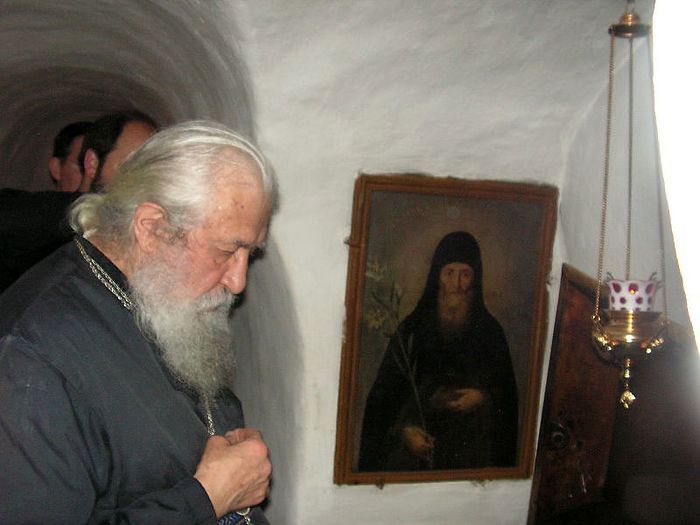 Metropolitan Laurus in the Kiev Caves Lavra
Metropolitan Laurus in the Kiev Caves Lavra
The way this unity was achieved is a lesson to all. Although today everyone loves Met. Laurus, as they also love St. John of San-Francisco... oh, the insults he had to endure along the way!
The conciliar and humble way Met. Laurus undertook the unification process was the key.
The issue of reunification was discussed at the IV All-Diaspora Council, which was convened on May 6, 2006, in the presence of the Kursk Root Icon, in the San-Francisco cathedral that St. John built, the same cathedral where Met. Laurus served at his funeral years ago.
Despite the fact that the best minds of the Church Abroad were present, they could not come to a consensus on how to approach unity. Vladyka Laurus found the answer—the Fourth Ecumenical Council!
At the Council of Chalcedon, all the greatest theologians of their day were called to discuss a far more complicated topic, and also found themselves deadlocked. Then, the Holy Fathers realized that in this church, lay the precious relics of St. Euphemia, an ancient saint who was tortured and martyred for Christ. They understood, rather than trusting in their own considerable intellect, that more than any living theologian, a simple girl who was tortured to death for Christ has far more boldness with Him. The Fathers placed both the Orthodox and heretical declarations on her relics, and sealed the church. Later they miraculously found the Orthodox Oros in her hand, and the Monophysite under her feet.
So it was, that Vladyka Laurus, together with council members, went to Saint John for help, placed their draft resolution on his relics, and prayed. After the prayers, everything went wonderfully.22 Vladyka also wisely directed that each paragraph of the resolution would be voted on separately, ensuring that everything be examined by the council, that all parties had a voice, and that nothing be forced unilaterally in an all-or-nothing way.23 The same can not be said for some other councils called these days…
The way Metropolitan Laurus approached unity is a golden example for all of us; we must learn from it.
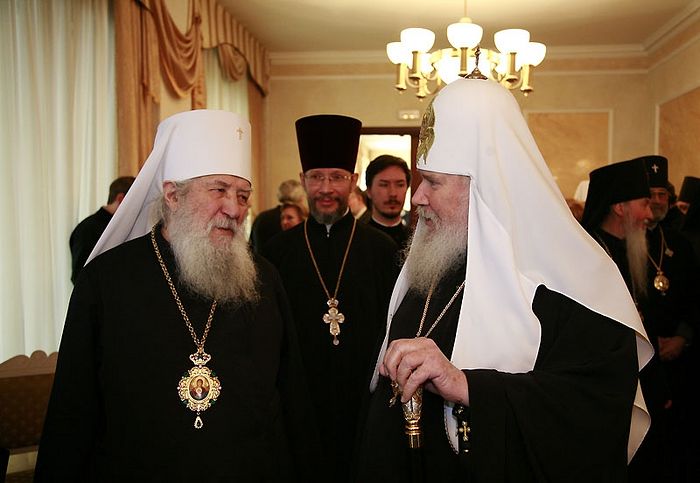 Metropolitan Laurus and Patriarch Alexy II
Metropolitan Laurus and Patriarch Alexy II
Vladyka Laurus was the great unifier of the Church, but he did it without arrogance or force. He made sure all voices, even those who disagreed, even those who insulted him, had a chance to speak and be heard.24
When the time came to make the resolution, he ensured it was made according to the finest conciliar traditions of the Church; and in the end, he brought the resolution to a Saint for intercessions, offering it up to God, trusting in prayer and not in his own considerable wisdom. On May 17, 2007, Ascension Day, the act of communion was signed, and the rest was literally history. A man who was once a little Rusyn boy who wanted to be a monk from age five, from the poor family in the small Carpathian village, made history.
The Witness of the ROCOR
On Schisms, the Unity of the Church, and the Triumph of Orthodoxy
If there is one fundamental message the ROCOR has for the Orthodox world, one lesson to be learned from her steadfast and constant witness, it is concerning right belief—Orthodoxy as being essential and indispensable for the Unity of the Church.
Throughout her witness, the ROCOR has always maintained that there can be no unity without right belief, and no communion between those who do not confess true Orthodox doctrine.
Like a voice from the bygone years, from the scattered children of Holy Rus’, wandering yet not lost in that valley of tears, throughout the witness abroad, this was what the ROCOR maintained.
First and paramount over all, true Orthodoxy is to be preserved and all unity to be based upon its worthy confession.
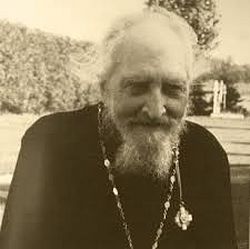 Archpriest Michael Pomazansky. This teaching was exemplified by perhaps one of the greatest theologians of the ROCOR, Archpriest Michael Pomazansky, who hailed from the glorious land of Volhynia in Western Ukraine.
Archpriest Michael Pomazansky. This teaching was exemplified by perhaps one of the greatest theologians of the ROCOR, Archpriest Michael Pomazansky, who hailed from the glorious land of Volhynia in Western Ukraine.
As a notable professor of Dogmatic Theology, Fr. Michael viewed it as a “way to maintain understanding and unity within the various Eastern Orthodox communities”.25 Indeed, for Fr. Michael, proper dogmatic theology and the unity of the church are inalienable; moreover, proper theology is the prerequisite to any union. This is evident in all his works,2627 especially his magnum opus, Orthodox Dogmatic Theology, now available online in both English and Russian.28
That is to say, right-belief is the standard for all unity, exemplified by his well-known quote: “The truth of the One Church is defined by the Orthodoxy of its members, and not by their quantity at one or another moment.”29
This was always the position of the ROCOR; any perceived strictness was motivated by the love the Synod and the people of the ROCOR had for Orthodoxy, and never hatred towards others. Her spiritual fruits by virtue of the traditionalist confession of Orthodoxy are self-evident, not only in myrrh streaming icons, but in great saints like John of Shanghai and San-Francisco, who unites the Russian and diaspora churches. The Unity Metropolitan Laurus reestablished was based upon Orthodoxy, and the restoration of historical justice in a conciliar fashion, not by renovationism and trampling the Orthodox canons by receiving schismatics and heretics and calling it “love and unity”.
Meanwhile, representatives of some of the more liberal trends in Orthodoxy have gone as far as to recently declare that St. John was born in schism, that ROCOR was schismatic, and as a result, they base upon these untruths justification for communion with schismatics, which is contrary to the entire canonical and dogmatic stance of Orthodoxy.
The ultra-liberal ecumenists certainly couldn’t base this rhetoric on Pillars of Orthodoxy, the choir of Saints who maintained that there is only One Church and schismatics are not a part of it.
So where did they come up with this idea? Most likely from their own reasoning, like Barlaam.
And where did figures like Protopresbyter Michael, and Met. Laurus learn theology? Through prayer and fasting, like St. Gregory of Palamas, from spiritual giants such as St. John the Wonderworker, a veritable “Little-Russian Chrysostom”. Our venerable spiritual fathers Michael and Laurus learned from the righteous, among whom they repose.
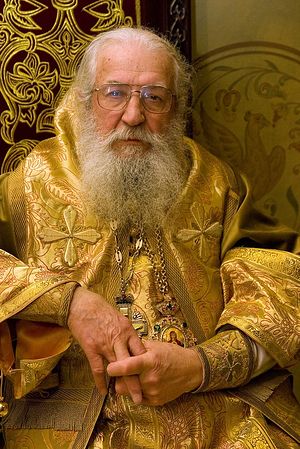 Father Michael was buried by then-Archbishop Laurus on November 9, 1988, the year of the millennium of the Baptism of Rus’ by St. Vladimir of Kiev, who (according to research and recent evidence) may have been born in Father Michael’s homeland—Volhynia, near the modern-day Budyatychi, Volyn Oblast, which corresponds to the Budutino or Budyatino (въ Будутинѣ) mentioned in the chronicles.3031
Father Michael was buried by then-Archbishop Laurus on November 9, 1988, the year of the millennium of the Baptism of Rus’ by St. Vladimir of Kiev, who (according to research and recent evidence) may have been born in Father Michael’s homeland—Volhynia, near the modern-day Budyatychi, Volyn Oblast, which corresponds to the Budutino or Budyatino (въ Будутинѣ) mentioned in the chronicles.3031
It’s so valuable to learn from people like Father Michael and Vladyka Laurus, because these people hailed precisely from those western, Ruthenian lands, where Orthodoxy had major confrontations with schism and the Unia with Rome. As many as were Orthodox confessed, even martyred, for the faith.
ROCOR as well as the OCA, and the general Orthodox diaspora has a great spiritual heritage from these lands, which now lie mostly in Western Ukraine, Poland, Slovakia, Hungary, and Romania.
We can learn a lot about the current situation in Ukraine from this history.
In several of my conversations with ROCOR Archpriests and faithful on the modern issues of schism within the church, particularly the Ukrainian question and relations with other local churches, a reoccurring theme has appeared: The example and experience of the ROCOR is very valuable to temper our approach to the current issues.
We can’t lose hope that divisions will end, that those on either side of the divide allow ourselves to take an overly isolationist, apocalyptic approach, or worse, to become self-righteous and pharisaic.
Orthodoxy must be confessed, schism and false teaching must be overthrown, but we can’t lose sight of the fact that in the end, Jesus Christ is the head of the Church, and it is He, not us who will set everything right in His Body.
From Met. Laurus, we learn that unity in the Church is preserved by right-belief, humility, trust in God, and the conciliar model.
The greatest lesson we can learn from the life of Vladyka Laurus is that in the end, no matter what forces work against the Church, if we remain faithful to her and the rock of her confession, we will all live to see the Triumph of Orthodoxy—the day on which twelve years ago Vladyka reposed in the hope of the resurrection. Eternal Memory!
Glory to Jesus Christ—Glory Forever!
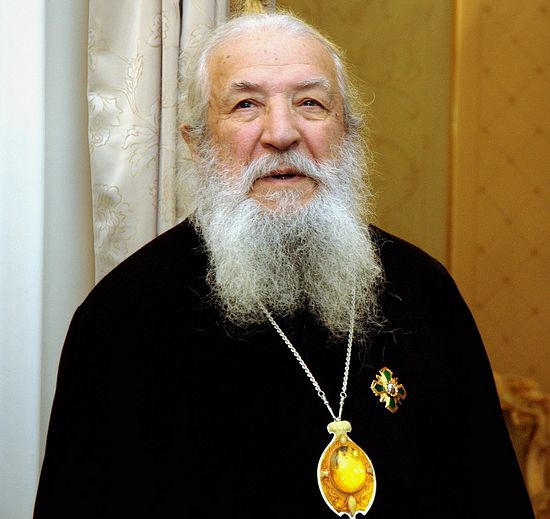 "May thy memory be eternal our father and high priest, for thou art worthy of blessedness and everlasting memory!"
"May thy memory be eternal our father and high priest, for thou art worthy of blessedness and everlasting memory!"

